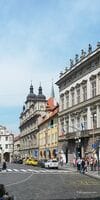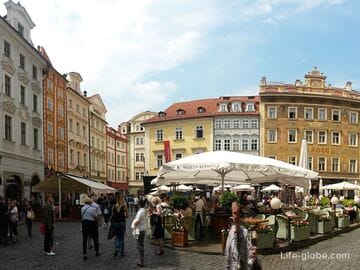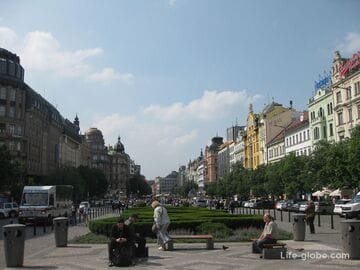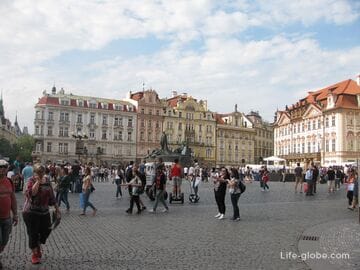Malostranské náměstí (Malostranské náměstí) is one of the most important and most visited squares in Prague, surrounded by historical palaces and home to one of the best viewing platforms in the city.
In the past, the square served as a market and a venue for various public events, and there was also a pillory on the square. During its history, the square has had different names: market, Malostransky Market, Shtepanske Namesti and Marshal Radetsky Square.
Malostranskaya Square was part of the so - called The Royal Way leading to Prague Castle (Pražský hrad), which is now a tourist route.
Today Malostranskaya Square is one of the most important and visited squares in Prague. It is located in the historical part of the city and acts as the center of the Mala Strana district.
The square has a number of historical houses and palaces and consists of two parts, which are connected together by the dominant of the whole square - the Church of St. Nicholas with a high observation tower. Around and near the square there are cafes, restaurants and accommodation facilities (hotels, apartments)
Malostranskaya Square is also a venue for farmers' markets in the warm season.

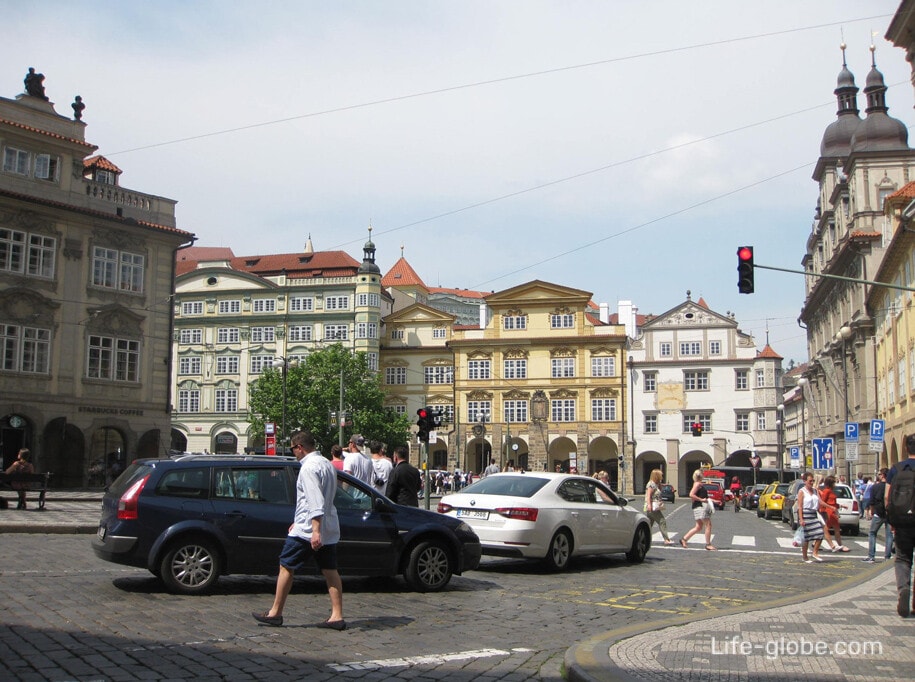
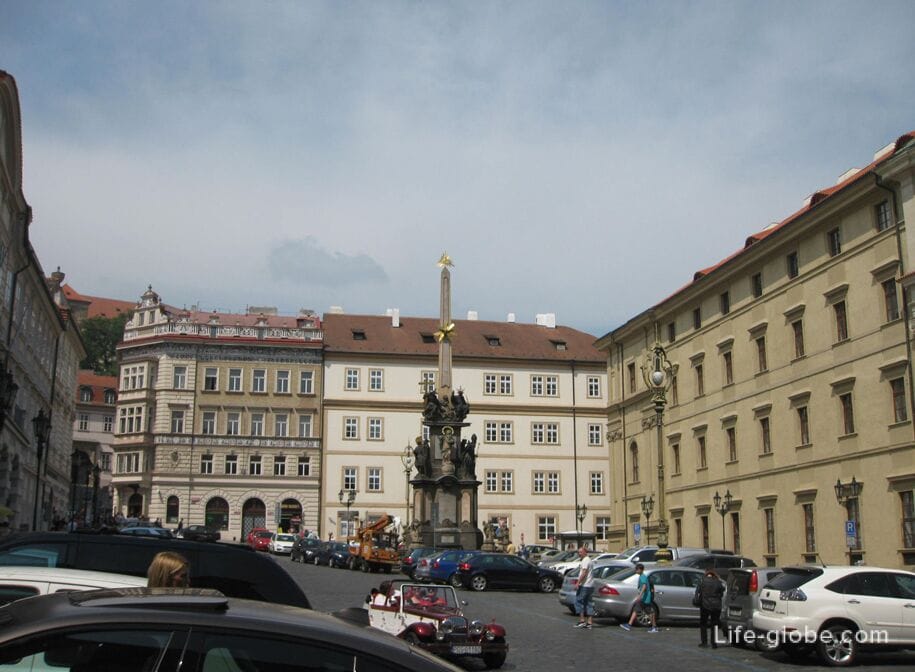
Sights of Malostranskaya Square
The Plague column
The plague column or column of the Holy Trinity (Sloup Nejsvětější Trojice) adorns the upper part of the Malostranska Square.
The column is made in the Baroque style and was erected as a token of gratitude after the end of the plague epidemic in 1713 and was fully completed in 1715. The architectural project belongs to Giovanni Battista Alliprandi, the sculptural design was carried out by Jan Oldrzych Mayer and Ferdinand Geiger. After the Great Famine of 1772, putti and vases from the workshop of Frantisek Ignaz Platzer were added to the column.
The upper part of the column is decorated with a triangular obelisk with the symbol of God's eye at the top and the image of the Holy Trinity - Christ, God the Father and the dove of the Holy Spirit in the lower part of the obelisk. On the middle tier of the column there is a statue of the Immaculate Virgin Mary and Czech patrons: St. Wojteh, Jan Nepomucki, Prokop, Lyudmila and Vaclav. The lower part of the column consists of a high plinth with marble signs and sculptures. The column is bordered by a balustrade on a low stepped base with putti and vases.
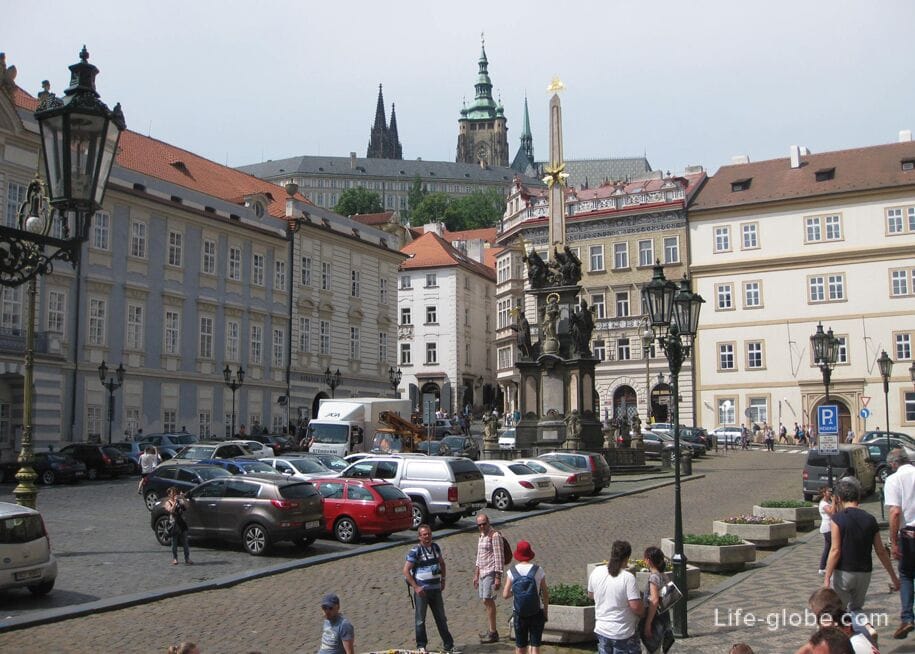
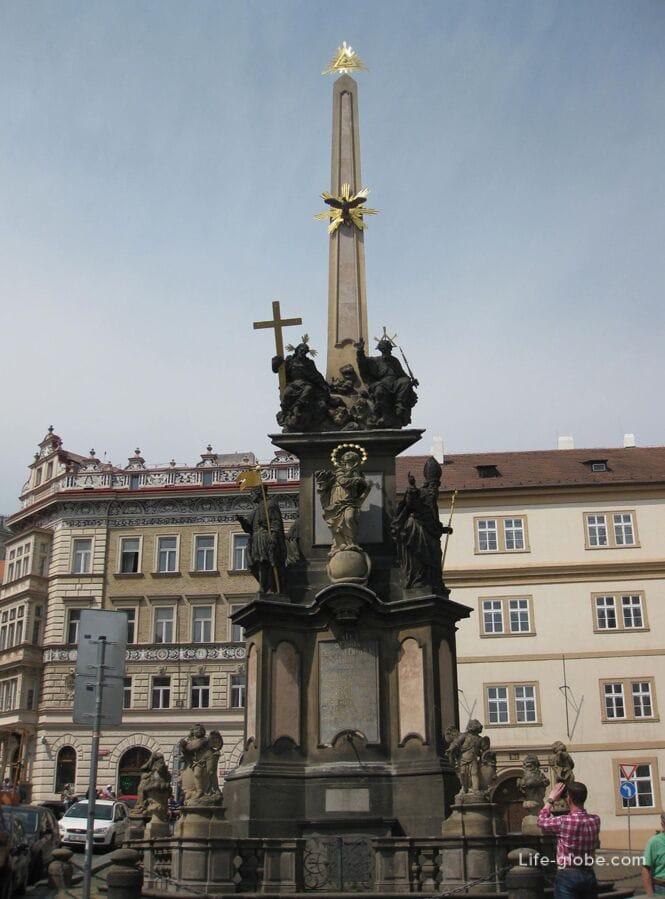
St. Nicholas Church and Observation Tower
The main dominant of Malostranskaya Square is the monumental Church of St. Nicholas or St. Nicholas Cathedral, as well as the Church of St. Mikulash (Kostel svatého Mikuláše Mala Strana).
The church with adjacent buildings is located in the center of the square, and its main facade faces the upper part of the square.
The church has a Baroque style, and due to its monumentality and architectural and artistic treatment, it is one of the most artistically significant Baroque buildings in Prague.
The facade of the church is decorated with sculptures and niches. The interior is distinguished by frescoes, sculptures and a Baroque organ.
Services and concerts are held in the church.
Entrance to the church is paid.
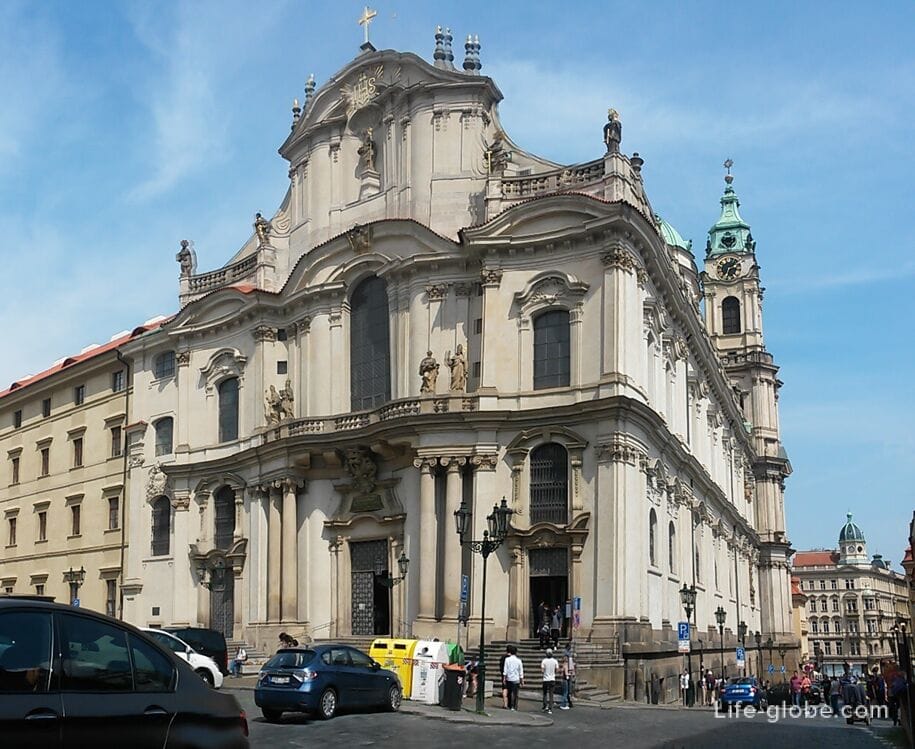
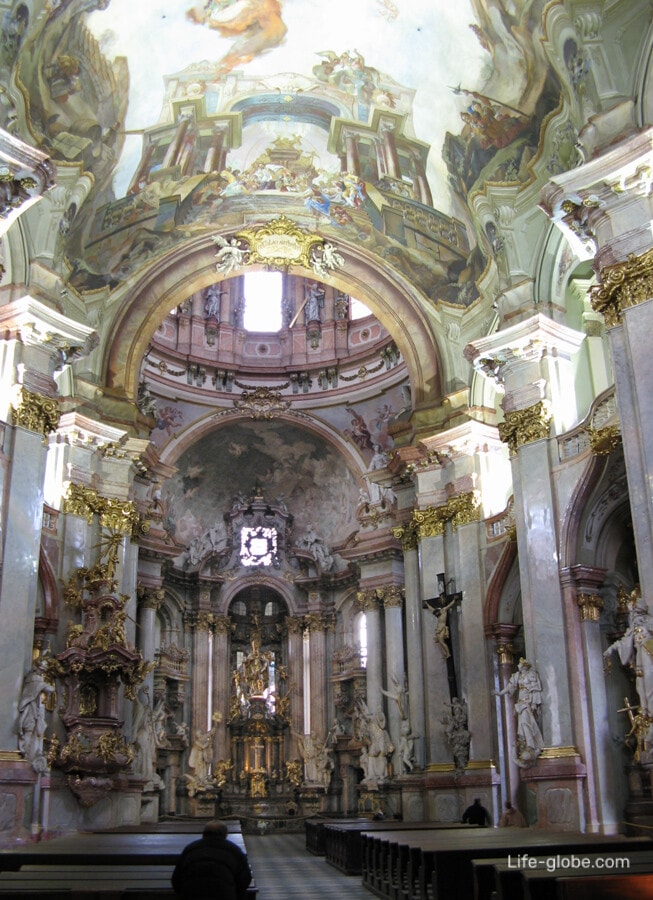
Adjacent to the church is a tall bell tower, which was erected by 1755 and during its history also served as a fire alarm tower (it was the last signal tower in Prague). Since the 1960s, it has been a state security observatory to monitor Western embassies around the tower.
Today, the tower belongs to the city (the Small Country of Prague), and not to the church. This fact is expressed by the coat of arms of a Small Country above the entrance to the tower.
The name of the tower is the Nikolskaya City Bell Tower (Svatomikulášská městská zvonice).
At a height of 65 meters, in the gallery of the tower, there is a public observation deck, which is reached by 215 steps. From the observation deck there are wonderful panoramic views of Prague.
The exhibition is located in the tower itself.
The ascent to the observation deck is paid. Learn more about the Church of St. Nicholas and the observation tower...
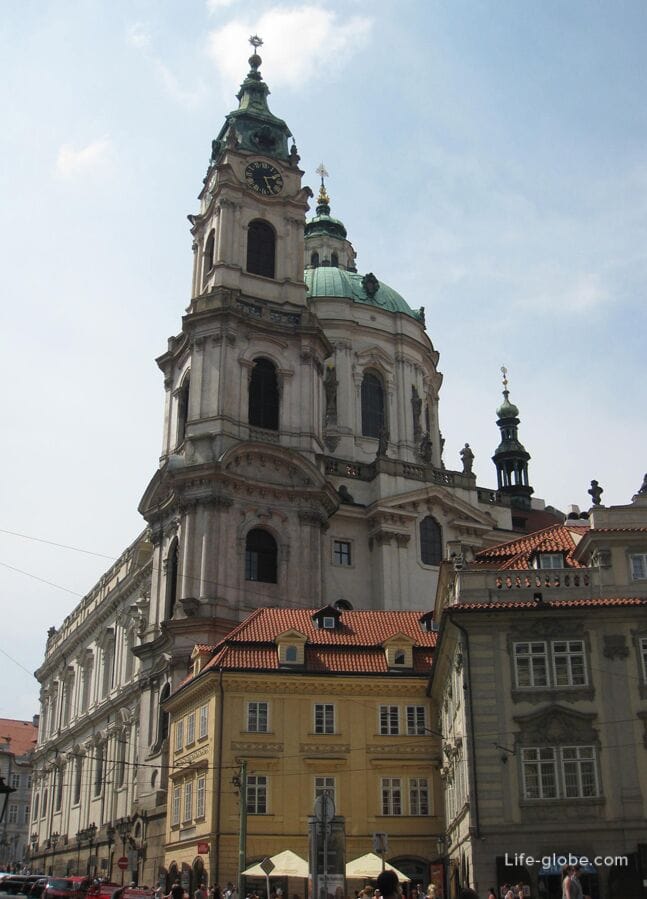
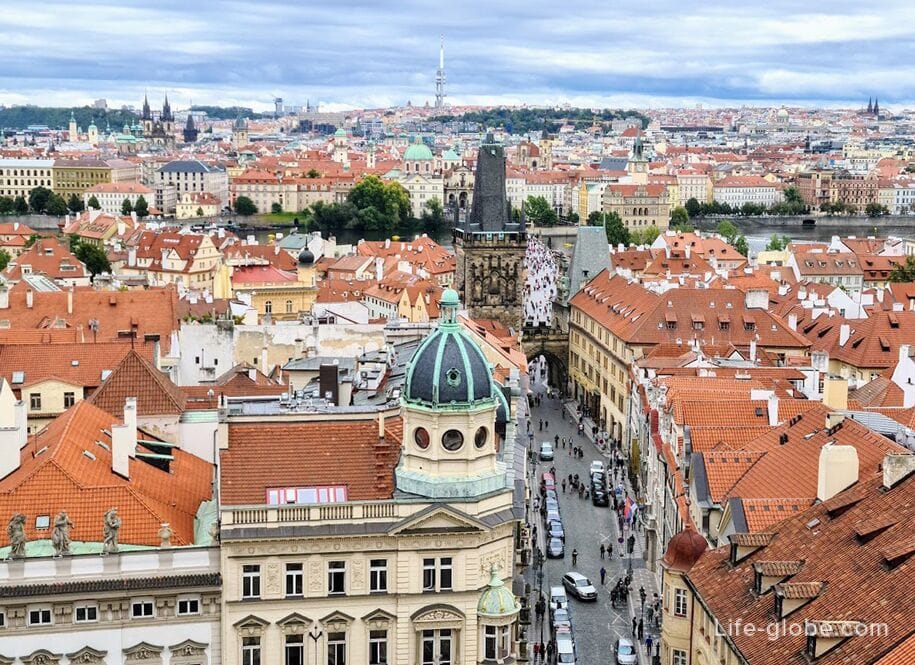
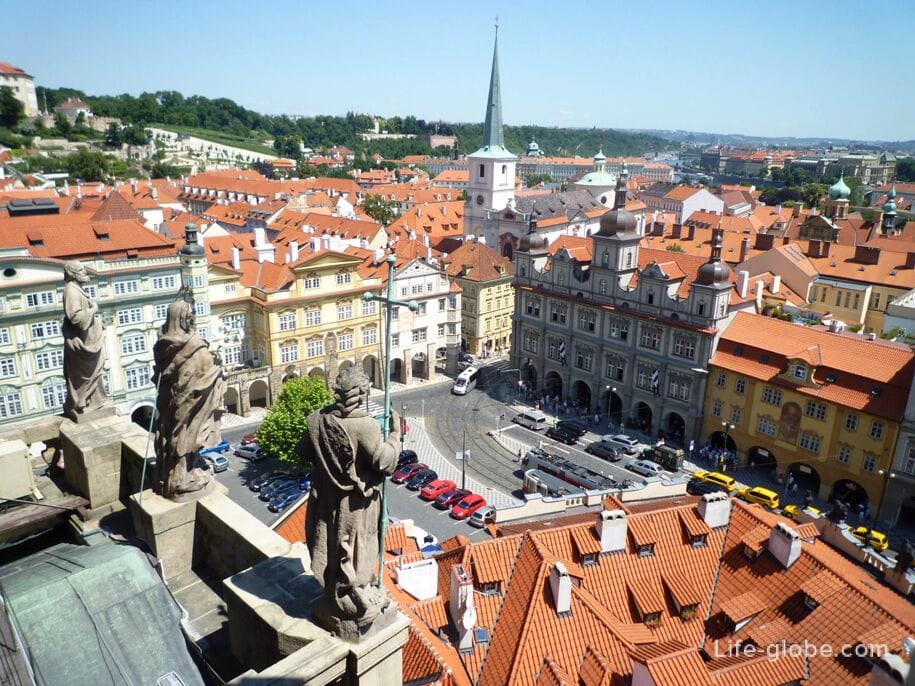
Professional House (Jesuit House and rotunda)
The Professional House (Profesní dům) is a former Jesuit house, which is adjacent to the Church of St. Nicholas and is a large building in the early Baroque style.
Together with the Church of St. Nicholas and several houses, it forms a block dividing Malostranskaya Square into lower and upper parts.
Originally, the building served as the home of the so-called professional brothers of the Society of Jesus (Jesuits). However, this was not the place where the Jesuits lived, they only maintained a gymnasium in a nearby building. Today the building houses the Faculty of Mathematics and Physics of Charles University.
View of the Professional House and the Church of St. Nicholas from Malostranskaya Square
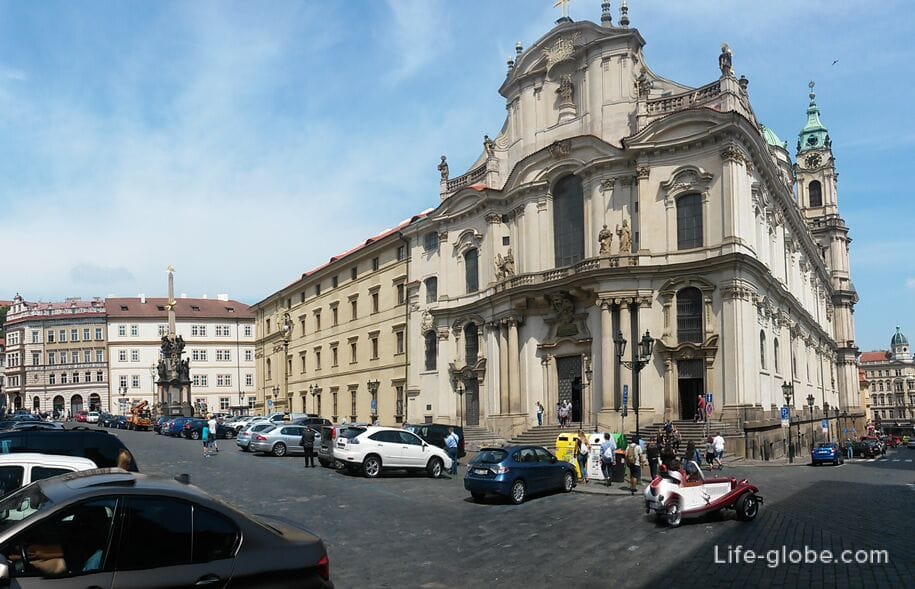
At the northwest corner of the former Jesuit house are the remains of the Romanesque Rotunda of St. Wenceslaus (Rotunda Sv. Václava).
The rotunda space is a relatively small area. During the excavations of the rotunda, archaeologists found a collection of jewelry from the 9th and 10th centuries, six skeletons of a knightly family from the time of John of Luxembourg and more than 3,000 fragments of vessels. However, the finds of parts of the rotunda building itself are also of great importance, including the paving stones on the floor.
All this makes the ruins of the rotunda one of the most important archaeological monuments of Prague, since, probably, all this suggests that the first Christian church of a Small Country and the oldest church outside the Prague Castle were located in this place.
Rotunda website: nase-rotunda.cz .
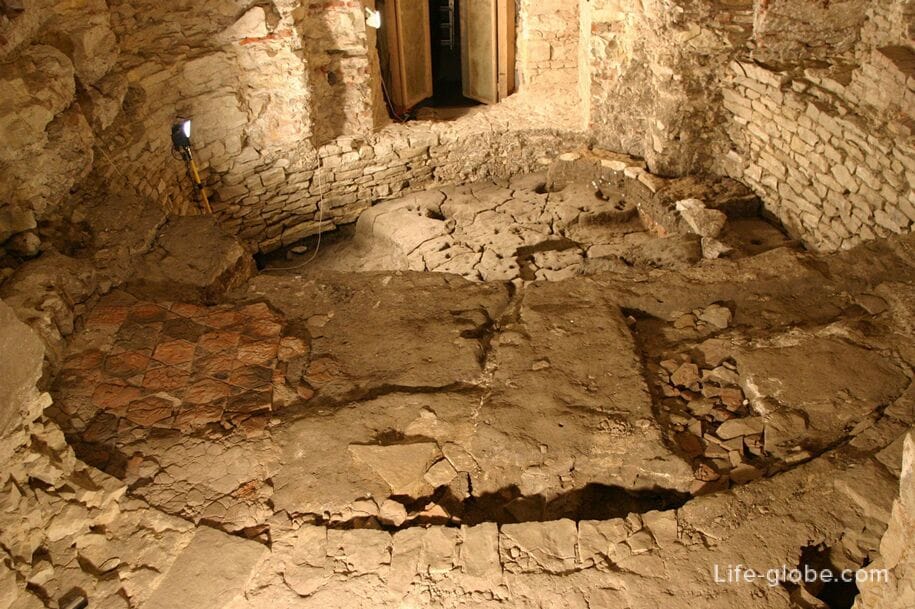
Lichtinstein Palace (Boguslav Martin Hall)
The Lichtenstein Palace or Lichtinstein Palace (Lichtenštejnský palác) is located opposite the main facade of the Church of St. Nicholas and was built in the Baroque style, and then rebuilt in the Classical style, on the site of five Romanesque houses.
The name of the palace "Lichtinstein" comes from the former owner of the houses in this place (since 1622) - Prince Karl Liechtenstein, who lived here until 1627.
Today, the palace houses the Faculty of Music and Dance of the Academy of Performing Arts. The building includes the concert hall of Bohuslav Martin (sál Bohuslava Martin?), which has an organ and a capacity of 200 people. The hall is mainly used for graduation concerts and private events.
Website: hamu.cz .
The address of the palace: Malostranské náměstí 258/13, 118 00 Praha 1 - Malá Strana.

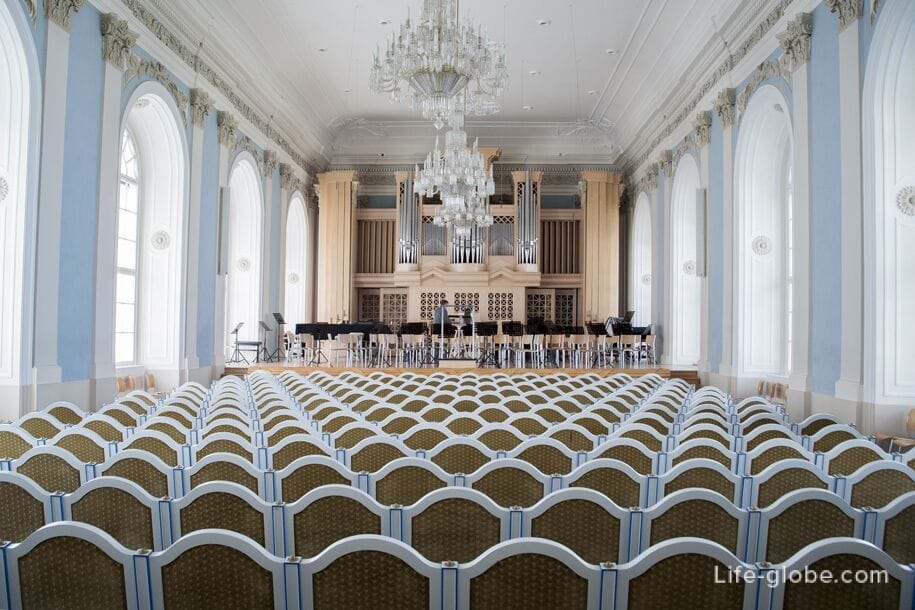
Harting Palace
The Harting Palace, also known as the Zenftenberg Palace, the Zemsky House or the Glauhovsky House (Hartigovský palác, Senftenberský palác, Zemský dúm, Glauchovský dúm), has a Baroque style and is adjacent to the Lichtinstein Palace.
The palace houses the leadership of the Academy of Performing Arts in Prague.
The volume of the current building was created by connecting two neighboring houses in 1645, and the palace appeared by rebuilding old houses after 1701 according to the project of Giovanni Battista Alliprandi, which was completed by Frantisek Maksmilian Kanka for Anna Josef Cherninova (widow of Herman Jakub Chernin). Subsequently, the palace changed owners and it was rebuilt.
The palace is a building of irregular layout with two courtyards. The facade of the main entrance, facing north to Malostranskaya Square, is asymmetrical and richly decorated, and also has an architectural semicircular balcony. The larger southern facade facing Tržiště Street is decorated more simply.
The address of the palace: Malostranském náměstí 259/12, 118 00 Praha 1 - Malá Strana.

Gremling Palace
The Gremling Palace or Gremling Palace (Gremling Palace), also known as the house at the stone table or At the cancer (Grömling(ov)ský palác, dówm U kamenného stolu, U raka), is located in the lower central part of Malostranska Square, near the tower of the Church of St. Nicholas.
The Rococo palace was built on the site of five bourgeois houses in 1764-1785 for the lawyer Karel from Gremling, designed by architect Josef Jager.
At first, the palace received the name of one of the original houses "at the Stone Table", but over time the name was changed to "Gremling" or "Kremlinkovsky" (Kremlinkovsky), depending on the name.
Today the building is one of the most artistically significant works of Prague Rococo architecture.
The upper, attic floor of the house looks unfinished. The palace has characteristic features, such as portals with carved upper corners, a special rococo stucco ornament on the window sills and rococo decorations (rocailles, garlands). The northern facade is decorated somewhat simpler than the main eastern facade, while the southern facade is made in a more classical style. The palace was decorated on the roof of the attic floor with stone vases and statues based on the ancient mythology of Ignaz Frantisek Platzer around 1787.
The remains of the basements and walls of the original Gothic and Renaissance houses (for example, vaults) have been preserved in the palace of the building.
Today, within the walls of the palace there is a cafe and a charming 4-star hotel Miss Sophie's Charles Bridge It offers rooms and apartments with free Wi-Fi, a safe, slippers, a hairdryer, toiletries and an equipped kitchenette with tea/coffee making facilities. Link to the hotel
The address of the palace: Malostranské náměstí 5/28, 118 00 Praha 1 - Malá Strana.

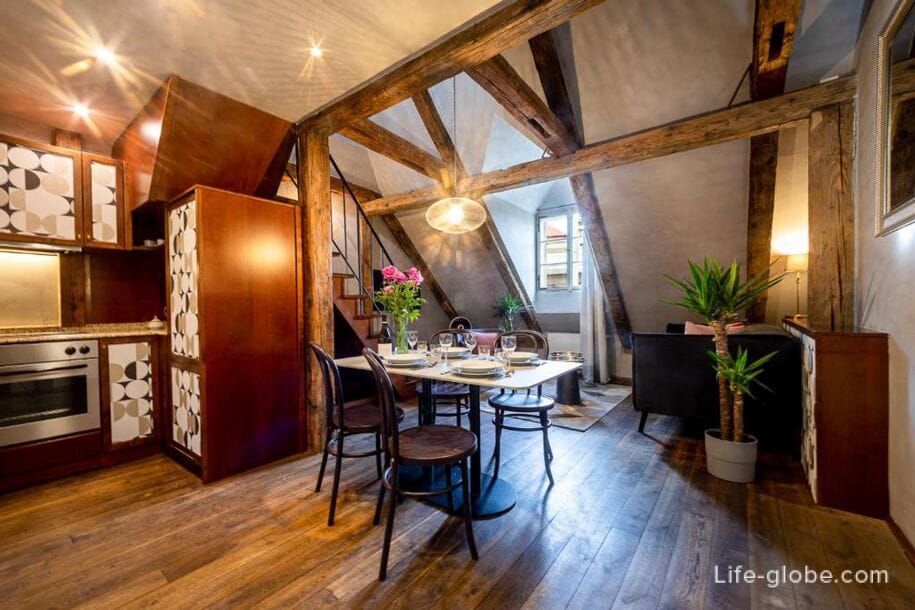
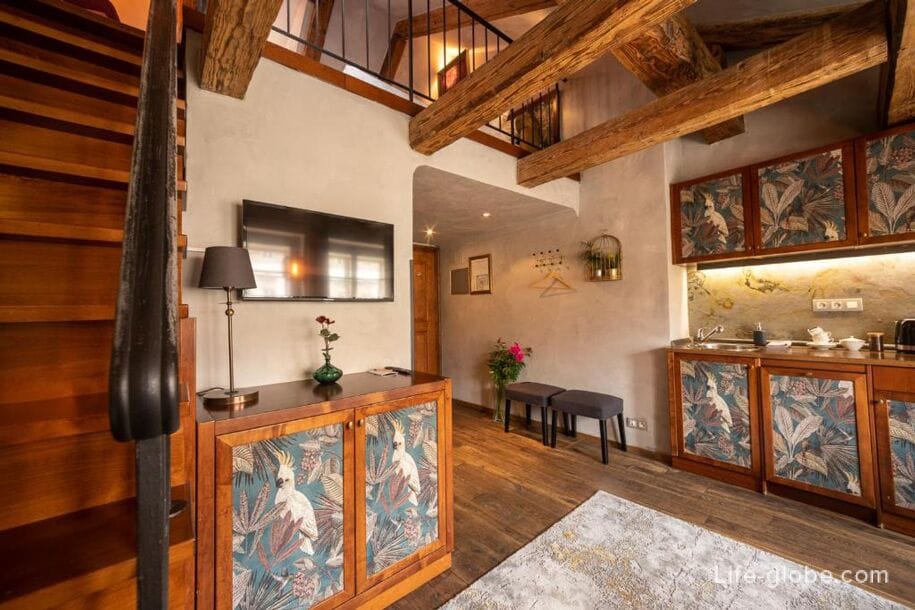
Kaiserstein Palace
Kaiserstein Palace or Petzoldu House (Kaiserštejnský palác, dówm U Petzoldów) is located in the lower eastern part of Malostranska Square.
The palace has a Baroque style and was built in 1714 by the reconstruction of two Renaissance houses.
The facade of the building is decorated with allegorical sculptures of the seasons and decorated vases by the Italian sculptor Ottavio Mosta.
On the ground floor of the rear building, Renaissance vaults and late Renaissance beamed ceilings decorated with paintings are still preserved.
Currently, the Kaiserstein Palace serves as a venue for conferences, weddings, exhibitions, concerts and other social events. Nine halls can accommodate up to 400 visitors. There is also a terrace in the building.
Palace website:kaiserstejnsky-palac.cz.
The address of the palace: Malostranské náměstí 37/23, 118 00 Praha 1 - Malá Strana.

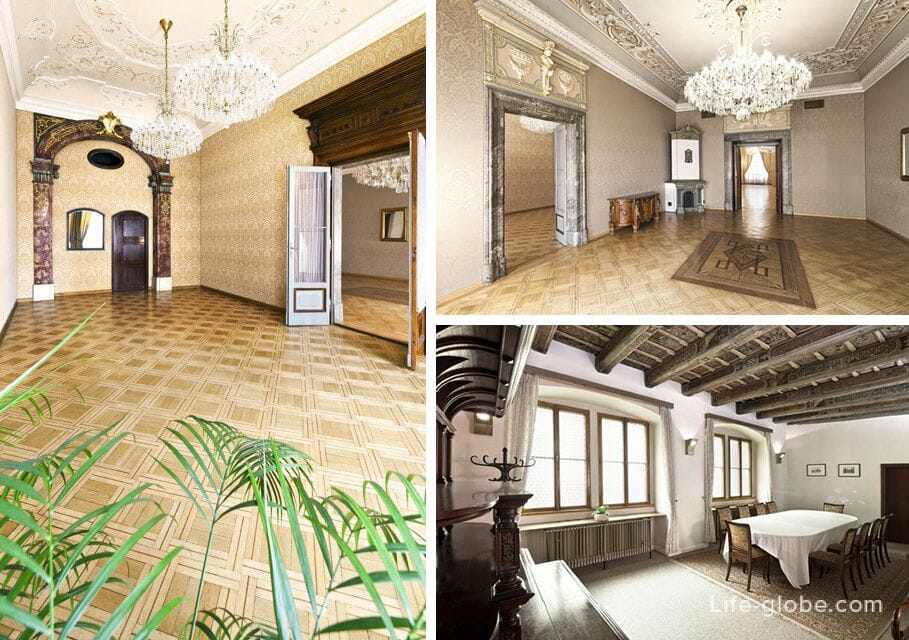
Malostranskaya conversation (Small Country Town Hall)
Malostranská beseda (Malostranská beseda) is a late Renaissance building that was the town hall of a Small Country from the end of the 15th century until 1784.
Throughout history, the building has undergone several reconstructions; after the recent general reconstruction, the exterior of the building retains its original appearance with towers and windows of the 17th century.
In 1868, the Malostranskaya Conversation, a cultural and social center, was founded in the building of the former town hall, which, with its rich range of cultural events and gastronomic services, operates today. There are: a restaurant and a pub with Czech cuisine and beer, as well as a music and theater club and an attic gallery with a rich program.
In the building of the Little Conversation there was a bell of St. Wenceslaus, located in the middle tower. The bell made of copper alloy weighs 160 kilograms and does not sway. He calls every quarter of an hour from 7:00 to 22:00.
The website of the Malostranskaya Conversation Cultural Center: malostranska-beseda.cz .
Building address: Malostranské náměstí 35/21, 118 00 Praha 1 - Malá Strana.


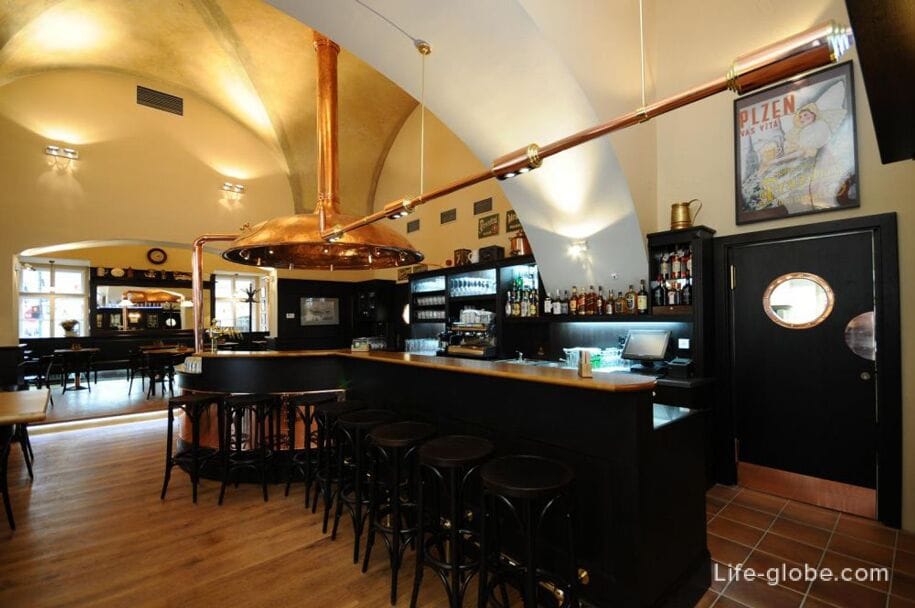
The Palace of the Smirzhitskys
The Palace of the Smirzhitskys or the house of U Montagu (Palác Smiřických, U Montágów) is located on the north side of Malostranskaya Square.
The palace was originally rebuilt in Renaissance and Baroque style and is now part of the complex of buildings of the Chamber of Deputies - office premises are located here, and the Chamber of Deputies takes place in the neighboring Thun Palace (Thunovský palác), located at: ulici Sněmovní 176/4.
Today's palace stands on the plots of three or four original medieval houses. The front house (on the side of Malostranskaya Square) was bought in 1573 by Yindrzych Smirzycki of Smirzyci, and a Renaissance-style palace was built in its place, which served as the main residence of the family.
After 1603, the corner towers were built during the time of Sigismund Smirzhitsky. In 1612, the palace was completed in the Baroque style. In the future, the palace changed owners. After 1763 it was acquired by Pavel Montag, who rebuilt and expanded it in 1764-1765 according to the project of Josef Jager, then the building was raised one floor and rebuilt in the Baroque style.
In 1895, the palace was acquired by the Provincial Assembly of the Kingdom of the Czech Republic and adapted for the needs of the Chamber of Deputies.
The Smirzhitsky Palace is a magnificent building with a central courtyard and corner polygonal towers.
The address of the palace: Malostranské náměstí 6/18, 118 00 Praha 1 - Malá Strana.

The Sternberg Palace
The Sternberg Palace or the Sternberg Palace (Šternberský palác) is adjacent to the Smyrzycki Palace.
The palace was founded in 1703 by connecting two Renaissance buildings, when they belonged to the nobleman František Damian from Sternberk. Currently, the building is part of the complex of buildings of the Chamber of Deputies of the Czech Parliament.
The Baroque painting "Coronation of the Virgin Mary", which was worshipped by the patron saints of the customer, has been preserved on the facade of the building. The ancestral coat of arms of the Sternbergs, decorated with the Order of the Golden Fleece with a crown, also reminds of the ownership of the palace.
Building address: Malostranské náměstí 7/19, 118 00 Praha 1 - Malá Strana.
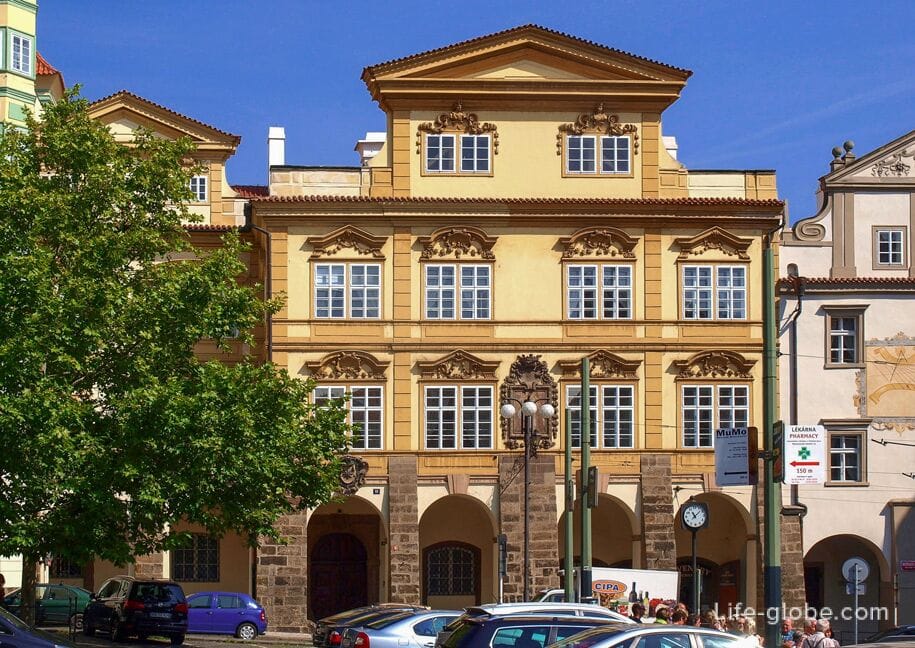
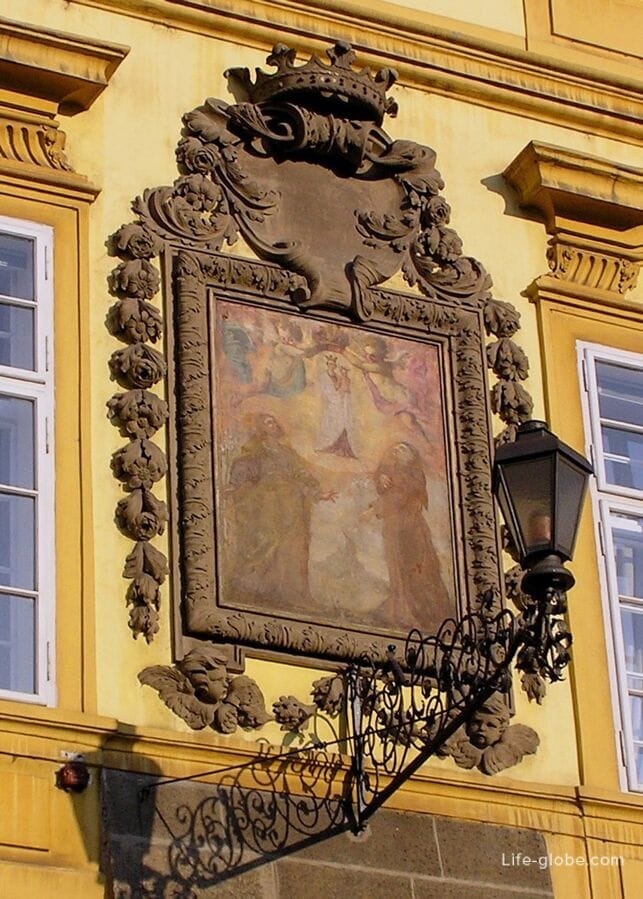
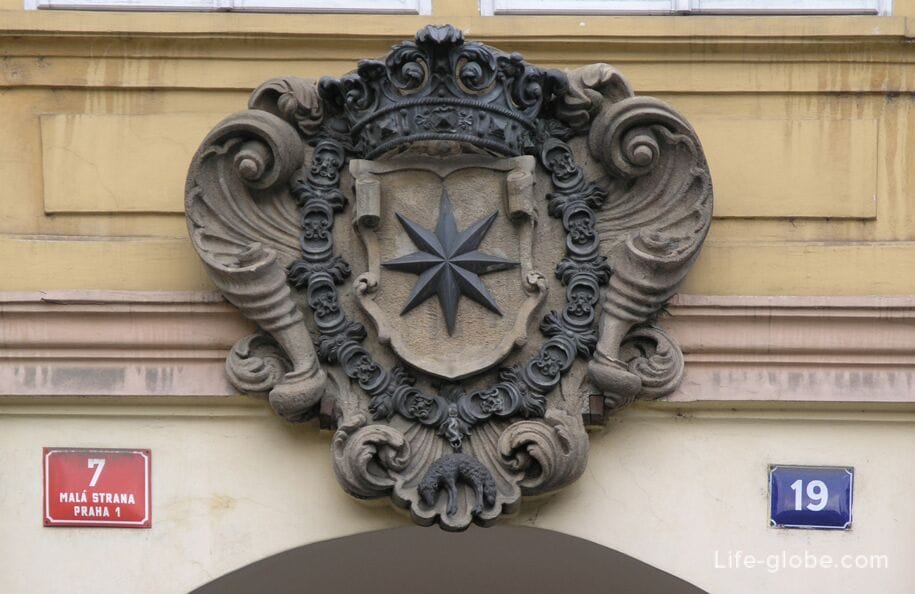
Velikovsky House (house with sgraffito painting)
Velikovsky House is a corner building on the northeast side of Malostranskaya Square, at the corner of Tomashskaya Street (Tomášské ulice).
Originally, there was a Gothic bourgeois house of the 14th century on this site, but after a big fire in Malaya-Strana in 1541, it was restored in the late Gothic style. The basements have been preserved since that time. Later the house was rebuilt in Renaissance style and supplemented with an arcade. Baroque reconstruction followed in the 17th century.
The house stands out with graffiti on the facade, originally the work of the sculptor Celestine Klouchek in 1899.
On the southern facade, facing Malostranskaya Square, there is a sundial showing not only real solar time, but also the old Czech time.
During the last reconstruction, the painted petal ceilings of the Renaissance and early Baroque were restored in the interior.
Today, the house, as well as two neighboring buildings, is included in the complex of buildings of the Chamber of Deputies of the Parliament of the Czech Republic.
House address: Malostranské náměstí 518/20, 118 00 Praha 1 - Malá Strana.
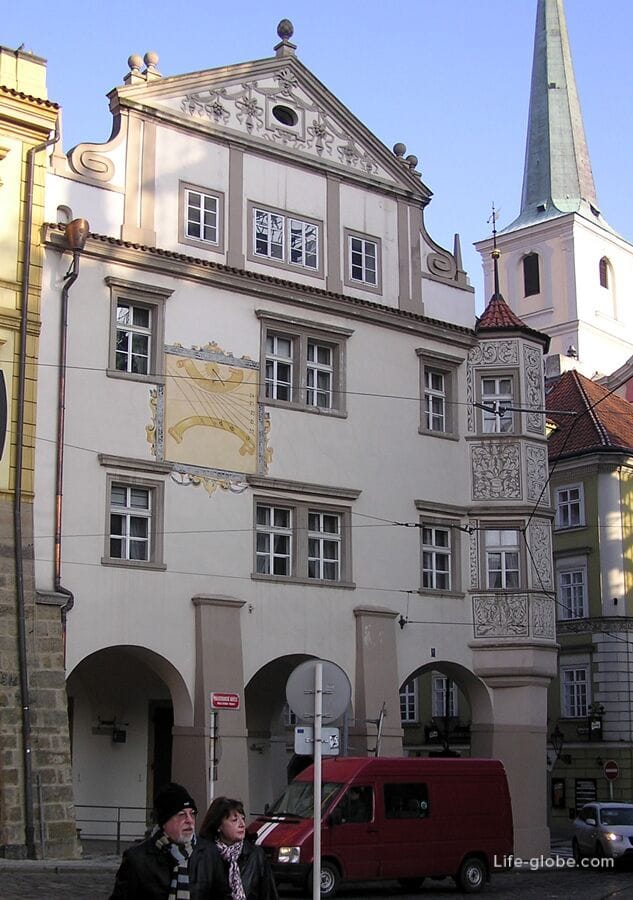
Coordinates of Malostranskaya Square: 50°05'17.0"N 14°24'14.0"E (50.088056, 14.403889).
All accommodation facilities in Prague (hotels, apartments, guest houses, etc.), including near Malostranskaya Square, in the historical center of the city and more remotely from those, can be viewed and booked here




